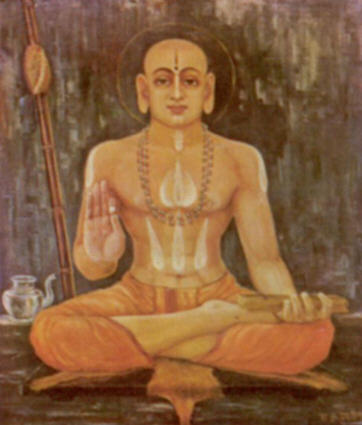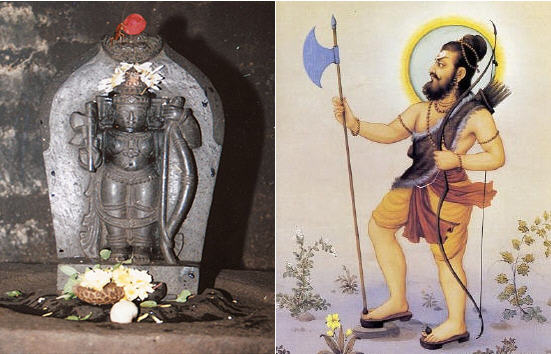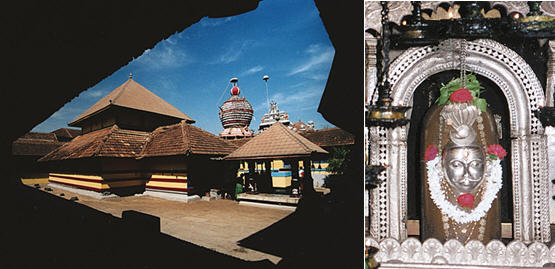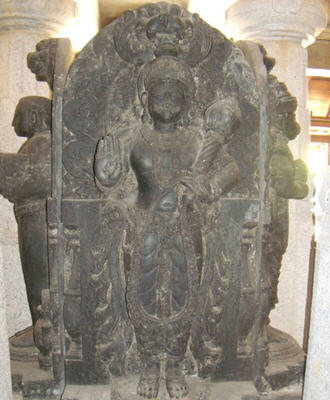The amazing story of how the Baala Krishna Deity crossed the ocean from faraway Dvaarakaa in Northwest India to Udupi in the south is told in Madhva-vijaya, the biography of Shrila Madhvaacaarya. Madhva wanted to have a temple of Lord Krishna in Udupi; the devotees could then worship and serve tOn that very dayhe Lord and ennoble their souls. Well, it so happened that in Dvaarakaa, one of the main places of Krishna’s pastimes on earth five thousand years ago, a Deity lay concealed within a large mass of gopi-candana clay (the yellowish clay Vaisnavas use daily in marking their freshly bathed bodies as temples of Lord Vishnu). No one knew the Deity was there, but because the lump of clay was exceedingly heavy, some sailors loaded it onto their merchant ship as ballast. On the ship’s southward journey, just off the coast of Udupi, a tempest blew the ship aground on a sandbank.
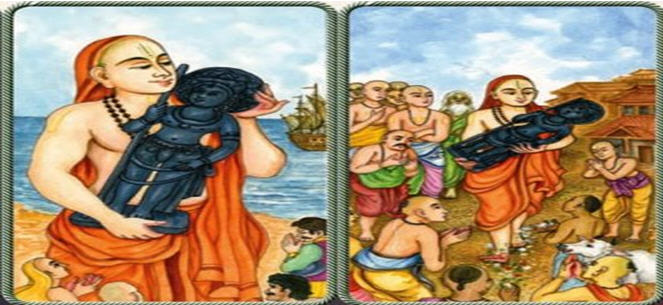
On that very day, Shrila Madhvaacaarya absorbed in composing Dvaadasha-stotra, his famous twelve-part poem praising Lord Krishna, had gone to the beach to bathe or, as some say, to receive the Lord. Upon seeing the ship caught fast on the sandbank and hearing the cries of the sailors in distress, Shrila Madhvaacaarya waved his cloth in their direction. This calmed the stormy seas, and the ship floated free. Madhva then guided the vessel to safety. Eager to show his appreciation, the captain offered Madhva whatever he wanted from the ship’s cargo. Madhva chose the heavy lump of gopi-candana clay.Disciple attendants of Madhvaacaarya had just started back to Udupi with the large lump of clay when, but a short distance from the beach, the lump broke in two, revealing the handsome Deity of Lord Baala Krishna and The deity of Balarama which Madhavacharya installed at Malpe beach, in the Vadabhandeshwara temple. The Krishna deity, he brought to Udupi, and installed in his Matha there.But now the combined effort of thirty of Madhva’s disciples could not budge the Deity. Only when Madhvaacaarya himself embraced and lifted the Deity as if He were a child did the Deity consent to be moved. In great transcendental ecstasy Madhva carried the Lord the four miles back to Udupi. On the way he completed the remaining seven parts of Dvaadasha-stotra, reciting the verses out loud. Back in Udupi, Madhva bathed the Lord in the lake known as Madhva-sarovara and enshrined Him in the ShriKrishna Matha.

Shrila Madhvaacaarya instituted rigorous standards for worshipping ShriKrishna, and whenever he was in Udupi he would personally perform the thirteen daily worship ceremonies for the Lord.
How the Deity of Baala Krishna had come to be buried in Dvaarakaa is told in a work from the seventeenth century by Raghuvarya Tirtha, an aacaarya in succession from Shrila Madhvaacaarya. Once, during the time of Lord Krishna’s manifest pastimes on earth, mother Devaki lamented to the Lord over her misfortune at never having witnessed the Lord’s childhood pastimes in Vrindaavana. She entreated the Lord to make her happy and fortunate, like mother Yashodaa, by showing some of His childhood feats and frolics.
The Supreme Personality of Godhead, just to give pleasure to His pure devotee, at once assumed the form of a small child and clambered all over Devaki’s lap. Later, when Devaki went to churn butter, Krishna, acting like an ordinary mischievous child, broke the churn, ate the lumps of butter, and even smeared butter all over his transcendental body. He then snatched the churning rod and rope from Devaki’s hands. After sporting like this for some time, the Lord again assumed His usual form of eternal youth. Mother Devaki was thrilled beyond measure to see this childhood pastime of the Lord.
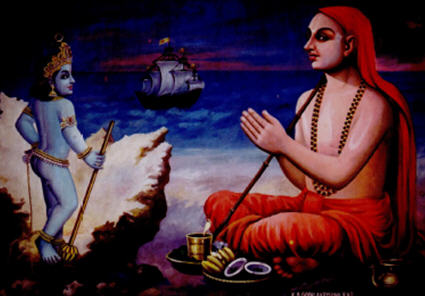
Queen Rukmini-devi, Lord Krishna’s consort, witnessed these pastimes, and the Lord’s mischievous behavior and childhood features enthralled her. To preserve the memory, she requested Lord to grant her a Deity similar to one seen that of childKrishna holding a churning rod and rope. Lord fulfilled her desire and Queen Rukminithus began to worship this Deity regularly. Later, after the Lord returned to the spiritual sky with His retinue, Arjuna deposited the Deity in a place called Rukminivana. In the course of centuries the Deity became completely covered with clay, and it remained in that condition near Dvaarakaa until merchant sailors brought it to Madhvaacaarya at Udupi.
Before his departure from this world, Shrila Madhvaacaarya appointed eight of his sannyaasi disciples to take charge of the worship at ShriKrishna Matha and to continue propagating Krishna consciousness in the region. Today the responsibility for the worship is rotated in two-year periods called paryaaya among eight sannyaasis in disciplic succession from the original eight. During the fourteen-year interim period between turns at paryaaya, each sannyaasi travels and preaches and raises funds for use when his turn for worship comes. During his paryaaya, he personally performs the thirteen daily ritual services to the Deity.
Each sannyaasi also heads his own Matha, where other Deities, ones given by Madhvaacaarya to the original eight sannyaasis, are worshipped. These eight Mathas are located along Car Street, a road that circles the Candramauleshvara and Ananteshvara temples and runs right past the main entrance to ShriKrishnaMatha. According to the significance of the festival being observed, sometimes only one cart and sometimes all three are used. A fourth cart, completely covered in silver, is used for special festivals.

Replete with a decorated elephant and a musical band, a parade on Car Street is an almost nightly event in Udupi. Residents and pilgrims alike turn out en masse to see the Lord riding high upon His cart and smiling beneficently upon the adoring devotees. The procession stops at intervals along the route, and the Lord is entertained by fireworks displays or worshiped by offerings from His many devotees. The parades start at eight and are usually over by nine-thirty.
